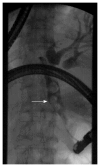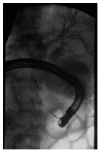Therapeutic endoscopic retrograde cholangiopancreatography in a patient with situs inversus viscerum
- PMID: 25987802
- PMCID: PMC4427701
- DOI: 10.3748/wjg.v21.i18.5744
Therapeutic endoscopic retrograde cholangiopancreatography in a patient with situs inversus viscerum
Abstract
Situs inversus viscerum (SIV) is a rare congenital condition characterized by complete transposition of all viscera. This anatomical pathology makes endoscopic retrograde cholangiopancreatography (ERCP) technically difficult. We report a new case of a 70-year-old Chinese male with total SIV who had obstructive jaundice. Magnetic resonance cholangiopancreatography demonstrated a number of stones in the gallbladder and common bile duct (CBD). Therapeutic ERCP was performed to relieve biliary obstruction and remove the CBD stones. This procedure started with the patient in a supine position and the endoscopist at the left side of the table. When the papilla was maintained, the patient was repositioned to a prone position and standard endoscopic sphincterotomy and endoscopic papillary balloon dilatation procedures were conducted. ERCP was performed successfully and relevant complications did not occur in this patient. We also present a review of the literature published between 1985 and 2014 in the PubMed and EMBASE databases. There were eight published cases during this period, with one each from America, Finland, India, Italy, South Korea and Pakistan, and two from Spain. Our case is the first reported in China.
Keywords: Common bile duct; Endoscopic papillary balloon dilatation; Endoscopic retrograde cholangiopancreatography; Endoscopic sphincterotomy; Situs inversus.
Figures






Similar articles
-
Successful access to the ampulla for endoscopic retrograde cholangiopancreatography in patients with situs inversus totalis: a case report.BMC Surg. 2017 Nov 28;17(1):112. doi: 10.1186/s12893-017-0307-x. BMC Surg. 2017. PMID: 29183311 Free PMC article.
-
Laparoscopic cholecystectomy and ERCP with sphincterotomy in an elderly patient with situs inversus.Am J Gastroenterol. 1992 Feb;87(2):218-20. Am J Gastroenterol. 1992. PMID: 1531164
-
[Removal of Choledocholith by Endoscopic Retrograde Cholangiopancreatography in a Situs Invsersus Patient].Korean J Gastroenterol. 2015 Dec;66(6):354-8. doi: 10.4166/kjg.2015.66.6.354. Korean J Gastroenterol. 2015. PMID: 26691194 Korean.
-
Endoscopic Management of Complex Biliary Stone Disease.Gastrointest Endosc Clin N Am. 2019 Apr;29(2):257-275. doi: 10.1016/j.giec.2018.11.004. Epub 2019 Feb 2. Gastrointest Endosc Clin N Am. 2019. PMID: 30846152 Review.
-
Obstructive jaundice due to a blood clot after ERCP: a case report and review of the literature.BMC Gastroenterol. 2018 Nov 3;18(1):163. doi: 10.1186/s12876-018-0898-4. BMC Gastroenterol. 2018. PMID: 30390657 Free PMC article. Review.
Cited by
-
Laparoendoscopic rendezvous procedure in a patient with situs inversus totalis: A case report and review of the literature.Clin Case Rep. 2020 Aug 11;8(12):2595-2599. doi: 10.1002/ccr3.3240. eCollection 2020 Dec. Clin Case Rep. 2020. PMID: 33363786 Free PMC article.
-
Successful ERCP for management of traumatic pancreatic disruption in a patient with situs inversus.Intractable Rare Dis Res. 2018 Feb;7(1):65-68. doi: 10.5582/irdr.2017.01072. Intractable Rare Dis Res. 2018. PMID: 29552451 Free PMC article.
-
Endoscopic retrograde cholangiopancreatography treatment of cholangitis stone in a patient with total situs inversus: A case report.World J Gastrointest Endosc. 2025 Jun 16;17(6):106347. doi: 10.4253/wjge.v17.i6.106347. World J Gastrointest Endosc. 2025. PMID: 40547559 Free PMC article.
-
Duodenoscope combined with laparoscopy in treatment of biliary stones for a patient with situs inversus totalis: A case report.Medicine (Baltimore). 2019 Feb;98(7):e14272. doi: 10.1097/MD.0000000000014272. Medicine (Baltimore). 2019. PMID: 30762727 Free PMC article.
-
A rotary papillotome plus adjustment of the monitor position to the foot side helps facilitate ERCP in a patient with situs inversus totalis.VideoGIE. 2021 May 28;6(8):362-364. doi: 10.1016/j.vgie.2021.05.002. eCollection 2021 Aug. VideoGIE. 2021. PMID: 34401632 Free PMC article.
References
-
- Gastrointestinal: situs inversus viscerum. J Gastroenterol Hepatol. 2002;17:1329. - PubMed
-
- Binmoeller KF, Schafer TW. Endoscopic management of bile duct stones. J Clin Gastroenterol. 2001;32:106–118. - PubMed
-
- Das A. Performing an ERCP with the patient in the supine position: necessity is the mother of improvisation. Gastrointest Endosc. 2008;67:1044–1045. - PubMed
-
- Lee SE, Kim HY, Jung SE, Lee SC, Park KW, Kim WK. Situs anomalies and gastrointestinal abnormalities. J Pediatr Surg. 2006;41:1237–1242. - PubMed
-
- Fonkalsrud EW, Tompkins R, Clatworthy HW. Abdominal manifestations of situs inversus in infants and children. Arch Surg. 1966;92:791–795. - PubMed
Publication types
MeSH terms
LinkOut - more resources
Full Text Sources
Other Literature Sources

